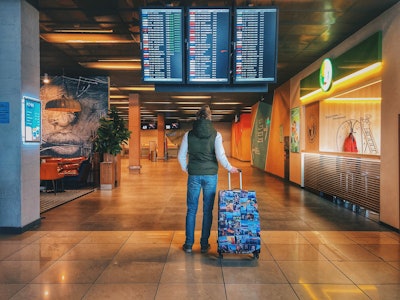
Toward the end of last year, the meeting industry seemed to be getting back on track. It might have been a completely new windy hybrid route, but nonetheless it was headed in the right direction, with major tentpole events and conferences like CES (and their international attendees) returning to in person.
Then the Omicron variant hit and large-scale events like the Sundance Film Festival decided to pivot back to entirely virtual experiences, seemingly putting the state of the industry in flux again—including the future of destination meetings and business travel. What was an optimist outlook turned murky as the industry faced the uncertainty caused by emerging COVID-19 variants.
In addition to navigating health and safety concerns, some companies experienced the cost-savings benefit of virtual meetings; business trips were the second-largest expense after employee salaries before the pandemic. For example, on Amazon's third-quarter earnings call in October 2020, CFO Brian Olsavsky said the company had saved nearly $1 billion in travel expenses that year because of the pandemic.
According to a recent report from The American Hotel & Lodging Association, in collaboration with Accenture, business travel is expected to stay down by more than 20% of its prepandemic volume. In 2019, business travelers constituted 52.5% of the industry’s overall room revenue, but it’s anticipated to represent just 43.6% in 2022.
As the destination meeting and event industry slowly recovers from the impact of the pandemic, we asked some hospitality and travel experts what they’re seeing right now and what trends to expect in 2022.
Remote Team Meetings
A dispersed team may make group travel bookings more difficult to arrange, but working remotely means that in-person gatherings are more important than ever. “Most people want to get their team back together,” said Samantha Hodge, general manager of The Hideaway at Hull Bay, a new beachfront estate in St. Thomas, which offers a group-buyout model to accommodate up to 36 guests. “Working remotely has taken a toll on workplace relationships, which are crucial to maintaining happy and healthy employees.”
 The Hideaway at Hull Bay is a new beachfront estate in St. Thomas, which offers a group-buyout model to accommodate up to 36 guests.Photo: Courtesy of The Hideaway at Hull Bay
The Hideaway at Hull Bay is a new beachfront estate in St. Thomas, which offers a group-buyout model to accommodate up to 36 guests.Photo: Courtesy of The Hideaway at Hull Bay
As has been a trend across all events, companies are opting for smaller, more intimate group sizes when planning business trips. “Our smaller, more remote destinations have been increasingly popular,” said Shelly Archer, managing partner of 360 Destination Group, a destination management company with over 17 locations in the U.S. “Typically, this indicates that clients are planning programs with fewer attendees overall and their budgets reflect that as well.”
Of course, small doesn’t always apply to the budget, especially after a two-year meeting drought. “Many clients are making up for those canceled events of the past, whether corporate or personal, and are willing to splurge a little,” said Karen Whitt, VP of sales and marketing at The Hartling Group, which oversees The Palms, The Shore Club and The Sands in Turks and Caicos. “We are seeing smaller groups with larger spend, and the 2022 numbers are rivaling pre-COVID budgets.”
Rodrigo Esponda, managing director of the Los Cabos Tourism Board, shared a similar sentiment, saying that "during the COVID-19 pandemic, we have seen that our clients have mostly maintained their budgets at prepandemic levels. While they may be planning smaller-sized meetings and events in terms of the number of people, they utilize their budget on other components—whether it be the venue selection, meeting add-ons or destination activities that provide a high level of safety while visiting the destination.”
In September 2021, Los Cabos recorded nearly 118,000 international arrivals, marking its most successful September month ever, with a 40% increase in international arrivals compared to 2019. From November 2021 to April 2022, there is a 45% increase in scheduled seats from the U.S. to the Los Cabos International Airport as compared to the same timeframe in 2019 to 2020. Esponda added that the majority of the region’s business clients come from California and Texas.
 “Many clients are making up for those canceled events of the past, whether corporate or personal, and are willing to splurge a little,” said Karen Whitt, VP of sales and marketing at The Hartling Group, which oversees The Palms (pictured), The Shore Club and The Sands in Turks and Caicos.Photo: Courtesy of The Hartling Group
“Many clients are making up for those canceled events of the past, whether corporate or personal, and are willing to splurge a little,” said Karen Whitt, VP of sales and marketing at The Hartling Group, which oversees The Palms (pictured), The Shore Club and The Sands in Turks and Caicos.Photo: Courtesy of The Hartling Group
Earlier this year, the 360 Destination Group saw a large number of clients requesting to push their meetings back due to the Omicron variant, Archer said. “However, unlike what we saw prior to 2022, the majority of these programs have just moved to later in the year as opposed to being canceled completely or postponed indefinitely.”
Not surprisingly, safety remains a top priority for planners and properties, with many offering on-site testing and adhering to strict protocols. Whitt, who noted that The Hartling Group’s properties have experienced few cancellations related to the Omicron variant, said that “the assurance of health and safety protocols” help “instill confidence and well-being” among travelers. The Shore Club and The Palms both have designated rapid-testing locations on the resort grounds. Also, Turks and Caicos requires all visitors 16 years of age and older to be fully vaccinated, as well as provide a negative COVID-19 test result and proof of insurance that covers COVID-19 medical costs.
Interestingly, according to the Development Counsellors International’s (DCI) newest edition of “Winning Strategies In Destination Marketing: A View From Meeting Planners,” only 29% of respondents noted that the security at a business event should be a joint effort between themselves and host destinations, compared to 70% of respondents in the 2018 edition. Thirty-six percent of respondents noted that security is the planner’s responsibility. “With the pandemic, there seems to have been a shift of responsibility, with planners owning more of the responsibility because I would imagine they feel a strong responsibility for keeping attendees safe,” said Daniella Middleton, DCI’s senior vice president of tourism.
Cancellation Policies
While pandemic-related concerns affected most of the results throughout the DCI study, cancellation policies topped the list with 73% of respondents reporting that they’re most concerned about that issue. “Meeting planners are dealing with tasks that are very much in the moment, from dealing with cancellation policies to understanding restrictions and guidelines in every destination. They are still in crisis mode,” Middleton explained. “It is important for destination markets and suppliers to understand how they can be valuable partners to planners during this moment in time.”
That’s why many destinations and properties continue to offer flexible booking arrangements as the industry handles the ups and downs of the pandemic. “A primary concern for planners is the potential scenario of needing to cancel hotel reservations or extend their stay due to potential positive cases with trip attendees,” Esponda said, adding that Los Cabos has “implemented a more flexible reservation policy across all hotels in the destination to support planners and travelers during this time.”
Popular Destinations
So, where’s everyone going? According to the DCI study, San Diego remains a top spot, with Montreal and Vancouver entering the charts for the first time. “Among the top six destinations, half are Canadian, suggesting a shift in focus among meeting planners to more northern cities,” Middleton said. “This is possibly a reflection of their COVID-19 responses and general control over the pandemic, as compared to the more affected areas in the U.S.”
Archer added that, currently, 360DG is experiencing the most activity in Santa Barbara, Napa, Austin, Orlando and Los Angeles.



















